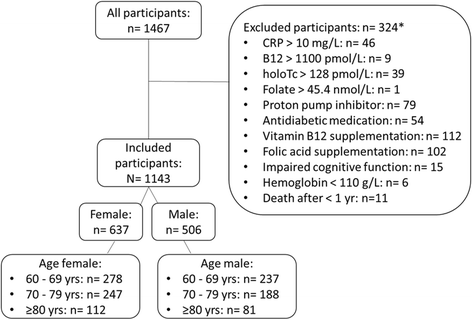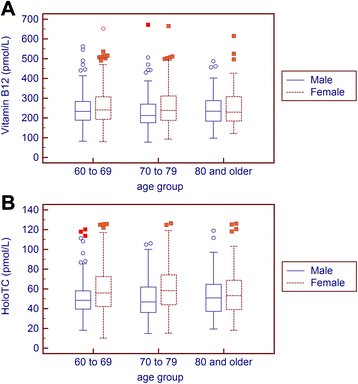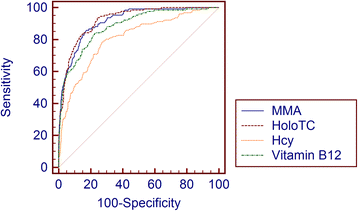Vitamin B12 and folate levels in healthy Swiss senior citizens: a prospective study evaluating reference intervals and decision limits
- PMID: 26163013
- PMCID: PMC4499201
- DOI: 10.1186/s12877-015-0060-x
Vitamin B12 and folate levels in healthy Swiss senior citizens: a prospective study evaluating reference intervals and decision limits
Abstract
Background: The vitamin B12 and folate status in nonanaemic healthy older persons needs attention the more so as decrease in levels may be anticipated from reduced haematinic provision and/or impaired intestinal uptake.
Methods: A total of 1143 subjectively healthy Swiss midlands participants (637 females and 506 males), ≥60 years of age were included in this study. Levels of vitamin B12, holotranscobalamin (holoTC), methylmalonic acid (MMA), homocysteine (Hcy), serum folate, red blood cell (RBC) folate were measured. Further, Fedosov's wellness score was determined. Associations of age, gender, and cystatin C/creatinine-based estimated kidney function, with the investigated parameters were assessed. Reference intervals were calculated. Further, ROC analysis was done to assess accuracy of the individual parameters in recognizing a deficient vitamin B12 status. Finally, decision limits for sensitive, specific and optimal recognition of vitamin B12 status with individual parameters were derived.
Results: Three age groups: 60-69, 70-79 and ≥ 80 had median B12 (pmol/L) levels of 237, 228 and 231 respectively (p = 0.22), holoTC (pmol/L) of 52, 546 and 52 (p = 0.60) but Hcy (μmol/L) 12, 15 and 16 (p < 0.001), MMA (nmol/L) 207, 221 and 244 (p < 0.001). Hcy and MMA (both p < 0.001), but not holoTC (p = 0.12) and vitamin B12 (p = 0.44) were found to be affected by kidney function. In a linear regression model Fedosov's wellness score was independently associated with kidney function (p < 0.001) but not with age. Total serum folate and red blood cell (RBC) folate drift apart with increasing age: whereas the former decreases (p = 0.01) RBC folate remains in the same bandwidth across all age groups (p = 0.12) A common reference interval combining age and gender strata can be obtained for vitamin B12 and holoTC, whereas a more differentiated approach seems warranted for serum folate and RBC folate.
Conclusion: Whereas the vitamin B12 and holoTC levels remain steady after 60 years of age, we observed a significant increment in MMA levels accompanied by increments in Hcy; this is better explained by age-related reduced kidney function than by vitamin B12 insufficiency. Total serum folate levels but not RBC folate levels decreased with progressing age.
Figures



Similar articles
-
Functional vitamin B12 deficiency and determination of holotranscobalamin in populations at risk.Clin Chem Lab Med. 2003 Nov;41(11):1478-88. doi: 10.1515/CCLM.2003.227. Clin Chem Lab Med. 2003. PMID: 14656029
-
Diagnostic accuracy of holotranscobalamin, methylmalonic acid, serum cobalamin, and other indicators of tissue vitamin B₁₂ status in the elderly.Clin Chem. 2011 Jun;57(6):856-63. doi: 10.1373/clinchem.2010.158154. Epub 2011 Apr 11. Clin Chem. 2011. PMID: 21482749
-
The usefulness of holotranscobalamin in predicting vitamin B12 status in different clinical settings.Curr Drug Metab. 2005 Feb;6(1):47-53. doi: 10.2174/1389200052997384. Curr Drug Metab. 2005. PMID: 15720207
-
The application and interpretation of laboratory biomarkers for the evaluation of vitamin B12 status.Ann Clin Biochem. 2025 Jan;62(1):22-33. doi: 10.1177/00045632241292432. Epub 2024 Oct 27. Ann Clin Biochem. 2025. PMID: 39367523 Free PMC article. Review.
-
Indicators for assessing folate and vitamin B12 status and for monitoring the efficacy of intervention strategies.Food Nutr Bull. 2008 Jun;29(2 Suppl):S52-63; discussion S64-6. doi: 10.1177/15648265080292S108. Food Nutr Bull. 2008. PMID: 18709881 Review.
Cited by
-
Personalising laboratory medicine in the 'real world': Assessing clinical utility, by clinical indication, of serum total B12 and Active-B12® (holotranscobalamin) in the diagnosis of vitamin B12 deficiency.Ann Clin Biochem. 2021 Sep;58(5):445-451. doi: 10.1177/00045632211003605. Epub 2021 Apr 23. Ann Clin Biochem. 2021. PMID: 33715445 Free PMC article.
-
Population Reference Values for Serum Methylmalonic Acid Concentrations and Its Relationship with Age, Sex, Race-Ethnicity, Supplement Use, Kidney Function and Serum Vitamin B12 in the Post-Folic Acid Fortification Period.Nutrients. 2018 Jan 12;10(1):74. doi: 10.3390/nu10010074. Nutrients. 2018. PMID: 29329201 Free PMC article.
-
Fewer US adults had low or transitional vitamin B12 status based on the novel combined indicator of vitamin B12 status compared with individual, conventional markers, NHANES 1999-2004.Am J Clin Nutr. 2021 Sep 1;114(3):1070-1079. doi: 10.1093/ajcn/nqab122. Am J Clin Nutr. 2021. PMID: 33963731 Free PMC article.
-
Methylmalonic Acid and Homocysteine as Indicators of Vitamin B-12 Deficiency in Cancer.PLoS One. 2016 Jan 25;11(1):e0147843. doi: 10.1371/journal.pone.0147843. eCollection 2016. PLoS One. 2016. PMID: 26807790 Free PMC article.
-
Dynamics and interactions of cobalamin and folate status during advanced aging - a longitudinal study in a community-dwelling cohort with multiple follow-ups.Nutr J. 2020 Jul 2;19(1):64. doi: 10.1186/s12937-020-00576-2. Nutr J. 2020. PMID: 32615974 Free PMC article.
References
-
- Sanghoon Shin D, Hee Min S, Russell L, Zhao R, Fiser A, Goldman D. Functional roles of aspartate residues of the proton-coupled folate transporter (PCFT-SLC46A1); a D156Y mutation causing hereditary folate malabsorption. Blood. 2010;116(24):5162–5169. doi: 10.1182/blood-2010-06-291237. - DOI - PMC - PubMed
MeSH terms
Substances
LinkOut - more resources
Full Text Sources
Other Literature Sources
Medical

